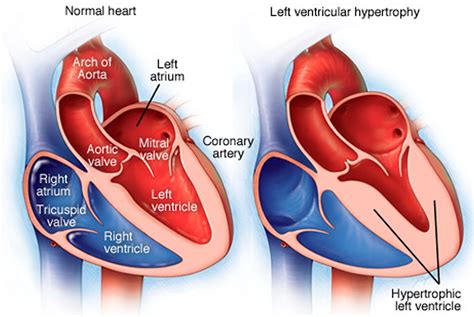lv wal | Lv wall motion abnormalities lv wal To diagnose left ventricular hypertrophy, a healthcare professional does a physical exam and asks questions about your symptoms and family's health history. The care professional checks your blood pressure and listens to your heart with a device called a stethoscope.
Piekļūstiet iecienītākajām ziņu vai sociālo saziņas līdzekļu vietnēm tieši no jaunas cilnes lapas. Lielākajā daļā Chrome tīmekļa lapu ir arī funkcija “Pieskarties, lai meklētu”. Varat aktivizēt Google meklēšanu no pašreizējās lapas, pieskaroties jebkuram vārdam vai frāzei. Tālruņa aizsardzība, izmantojot .
0 · reasons for left ventricular hypertrophy
1 · normal Lv wall thickness
2 · myocardial wall
3 · lvh with repolarization abnormalities
4 · increased Lv wall thickness
5 · Lv wall thickness on echo
6 · Lv wall thickness normal values
7 · Lv wall motion abnormalities
Left ventricular hypertrophy (LVH) is when the heart’s main pumping chamber, the left ventricle, becomes thicker and less able to pump blood efficiently. It usually develops because of.
Left ventricular hypertrophy, or LVH, is a term for a heart’s left pumping chamber that has thickened and may not be pumping efficiently. Sometimes problems such as aortic . Left ventricular hypertrophy (LVH) makes it harder for the heart to pump blood efficiently. It can result in a lack of oxygen to the heart muscle. It can also cause changes to . Left ventricular hypertrophy is a thickening of the wall of the heart's main pumping chamber, called the left ventricle. This thickening may increase pressure within the heart. The condition can make it harder for the heart to pump blood. Left ventricular hypertrophy, or LVH, is a term for a heart’s left pumping chamber that has thickened and may not be pumping efficiently. Sometimes problems such as aortic stenosis or high blood pressure overwork the heart muscle.
Left ventricular hypertrophy (LVH) makes it harder for the heart to pump blood efficiently. It can result in a lack of oxygen to the heart muscle. It can also cause changes to the heart’s conduction system that make it beat irregularly (arrhythmia). To diagnose left ventricular hypertrophy, a healthcare professional does a physical exam and asks questions about your symptoms and family's health history. The care professional checks your blood pressure and listens to your heart with a device called a stethoscope.
Left ventricular hypertrophy (LVH) is when the heart’s main pumping chamber, the left ventricle, becomes thicker and less able to pump blood efficiently. It usually develops because of. The LV calculator allows you to successfully compute the left ventricular mass, LVMI, and the relative wall thickness of a heart. Recently, the consensus of the American Heart Association (AHA) 21 divided the LV into 4 walls: septal, anterior, lateral, and inferior; in turn, the 4 walls were divided into 17 segments: 6 basal, 6 mid, 4 apical, and 1 segment being the apex (Figure 2). The left ventricle (LV) does not empty out with each contraction. Normally the left ventricle (LV) ejects between 50% and 70% of the blood it contains. Below is an echocardiogram of a patient with a normal ejection fraction (EF= 55-60%).
Hypertrophic cardiomyopathy is characterized by left ventricular hypertrophy (wall thickness >12-15 mm; normal wall thickness is 12 mm or less, measured during diastole) without obvious etiology. Associated right ventricular hypertrophy may be seen in 15-17% of cases.
reasons for left ventricular hypertrophy
Increased left ventricular myocardial thickness (LVMT) is a feature of several cardiac diseases. The purpose of this study was to establish standard reference values of normal LVMT with cardiac magnetic resonance and to assess variation with image acquisition plane, demographics, and left ventricular function. Left ventricular hypertrophy is a thickening of the wall of the heart's main pumping chamber, called the left ventricle. This thickening may increase pressure within the heart. The condition can make it harder for the heart to pump blood. Left ventricular hypertrophy, or LVH, is a term for a heart’s left pumping chamber that has thickened and may not be pumping efficiently. Sometimes problems such as aortic stenosis or high blood pressure overwork the heart muscle. Left ventricular hypertrophy (LVH) makes it harder for the heart to pump blood efficiently. It can result in a lack of oxygen to the heart muscle. It can also cause changes to the heart’s conduction system that make it beat irregularly (arrhythmia).
To diagnose left ventricular hypertrophy, a healthcare professional does a physical exam and asks questions about your symptoms and family's health history. The care professional checks your blood pressure and listens to your heart with a device called a stethoscope.
Left ventricular hypertrophy (LVH) is when the heart’s main pumping chamber, the left ventricle, becomes thicker and less able to pump blood efficiently. It usually develops because of.
The LV calculator allows you to successfully compute the left ventricular mass, LVMI, and the relative wall thickness of a heart.
normal Lv wall thickness
myocardial wall
lvh with repolarization abnormalities
Recently, the consensus of the American Heart Association (AHA) 21 divided the LV into 4 walls: septal, anterior, lateral, and inferior; in turn, the 4 walls were divided into 17 segments: 6 basal, 6 mid, 4 apical, and 1 segment being the apex (Figure 2). The left ventricle (LV) does not empty out with each contraction. Normally the left ventricle (LV) ejects between 50% and 70% of the blood it contains. Below is an echocardiogram of a patient with a normal ejection fraction (EF= 55-60%).
Hypertrophic cardiomyopathy is characterized by left ventricular hypertrophy (wall thickness >12-15 mm; normal wall thickness is 12 mm or less, measured during diastole) without obvious etiology. Associated right ventricular hypertrophy may be seen in 15-17% of cases.
kim kardashian pregnant givenchy

i believe in the power of love givenchy shirt
[Epic Seven] How to Use the NEW Level Up System 2021! (Promotion and Enhancing Explained!) PlaybyPlayGaming. 3.02K subscribers. 436. 30K views 2 years ago. Let's take a quick look at what.
lv wal|Lv wall motion abnormalities

























